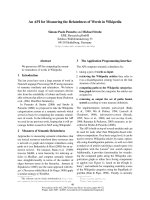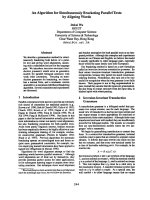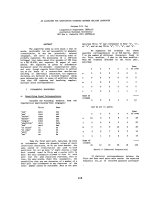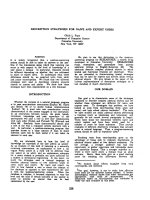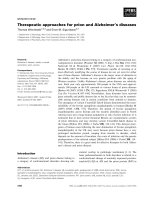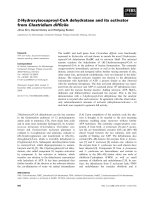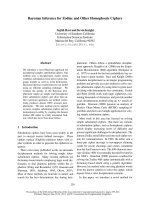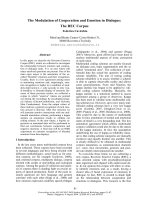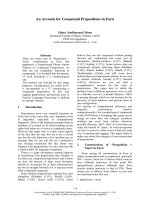Báo cáo khoa học: "An “encyclopaedia” for anaesthesia and intensive care medicine: is it possible" pdf
Bạn đang xem bản rút gọn của tài liệu. Xem và tải ngay bản đầy đủ của tài liệu tại đây (68.05 KB, 1 trang )
1
Available online />An encyclopaedia is described as ‘a work containing
exhaustive information on some one branch of knowledge’
(Oxford English Dictionary). This is truly a high pretension of
Steven Yentis and his co-editors for their new edition of
Anaesthesia and Intensive Care Medicine A–Z: An
Encyclopaedia of Principles and Practice. According to the
Preface, the authors have tried ‘to produce a readily
accessible source of information’ for candidates preparing for
the examinations at the Royal College of Anaesthetists. The
first edition found acceptance from a broad readership –
trainees and practitioners, anaesthetists and intensivists.
Meanwhile, the content has extended markedly, and the
current version has more than 550 pages.
As one leafs through the book, the high quality of the
166 figures and 35 tables is striking. Combining due
simplicity and necessary accuracy, the figures present
elementary facts about basic anatomy, physiology,
pharmacology and specific topics. Within the text,
numerous cross-references are of considerable help to the
reader in finding related topics and important basic
information. The short historical reviews support a better
understanding of the complex background. Another feature
of the book is the parallelism of scientific basics and
practical issues; for example, cartoons and precise
descriptions of a chest drainage system or symbols of
electrical equipment are presented with the same care as
complex plans of the lumbar plexus or the anatomy of the
mediastinal tract. This kind of high-quality work has clearly
required years of careful analysis, and I am sure that this
will be valued by a broad readership.
Some criticisms, however, have to be raised. After thorough
review, this book refers predominantly to topics about
anaesthesia, whereas intensive care medicine is not always
presented in an updated manner. Let us take some
examples. The management of severe sepsis and septic
shock is not in accordance with current recommendations.
Very often, the authors refer to recent (2003) review articles
dealing with pathophysiological aspects of the disease. In
contrast, none of the major randomized clinical trials from
2001 and 2002, which are part of current guidelines, are
cited. Time cannot be the problem, because more recent
publications are mentioned. Surprisingly, terms such as
‘antithrombin’ and ‘immunonutrition’ are not mentioned.
Furthermore, there is no statement regarding
immunoglobulins, and no clear recommendation for
catecholamine therapy in septic patients is to be found.
Finally, recommendations for preventive measures against
ventilator-associated pneumonia (such as daily sedation
vacation, head-up positioning and low tidal volume) are not
mentioned. Taken together, this book is not the ideal source
for up-to-date treatment of severely ill patients.
Is this a swan song? Definitely not! I am optimistic that the
book will succeed in reaching a broad readership. However,
the limitations must be clearly stated. For the young
anaesthetist as well as for the practising nurse, this book is a
fascinating tool for getting an overview when looking at
special items, as it offers both clinical evaluation of
therapeutic approaches and basic physiology. For the
intensivist, some specific information is definitely missing. In
the Preface, the Editors express their hope ‘that this book will
continue to be useful to all staff who help us care for our
patients on a daily basis…’. I feel that this is not only a
fulfilled hope, but, on the basis of the present result, a fact for
which the authors are to be congratulated.
Competing interests
The author(s) declare that they have no competing interests.
Book report
An “encyclopaedia” for anaesthesia and intensive care medicine:
is it possible?
Herwig Gerlach
Professor of Anesthesiology and Intensive Care Medicine, Director, Department of Anesthesiology,
Intensive Care and Pain Management, Vivantes, Klinikum Neukoelln, Berlin, Germany
Corresponding author: Herwig Gerlach,
Published online: 1 February 2005
Critical Care 2005, 9:E14 (DOI 10.1186/cc3056)
This article is online at />© 2005 BioMed Central Ltd
Yentis SM, Hirsch NP, Smith GB (Eds): Anaesthesia and Intensive Care Medicine A–Z: An Encyclopaedia of
Principles and Practice, 3rd edition. Edinburgh: Butterworth Heinemann; 2004. 564 pp. ISBN 0-7506-8777-0
